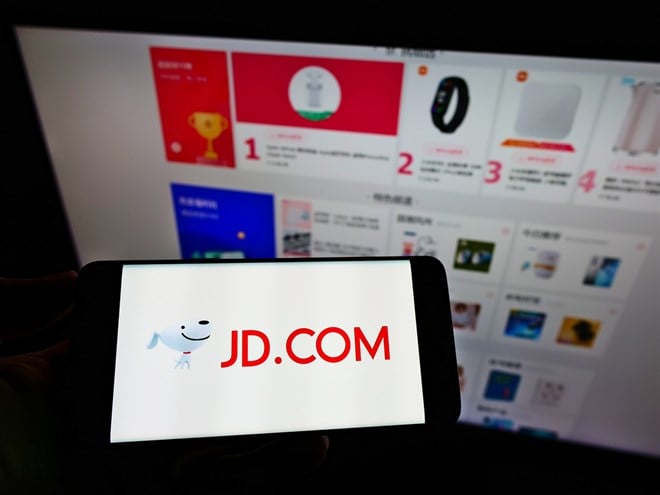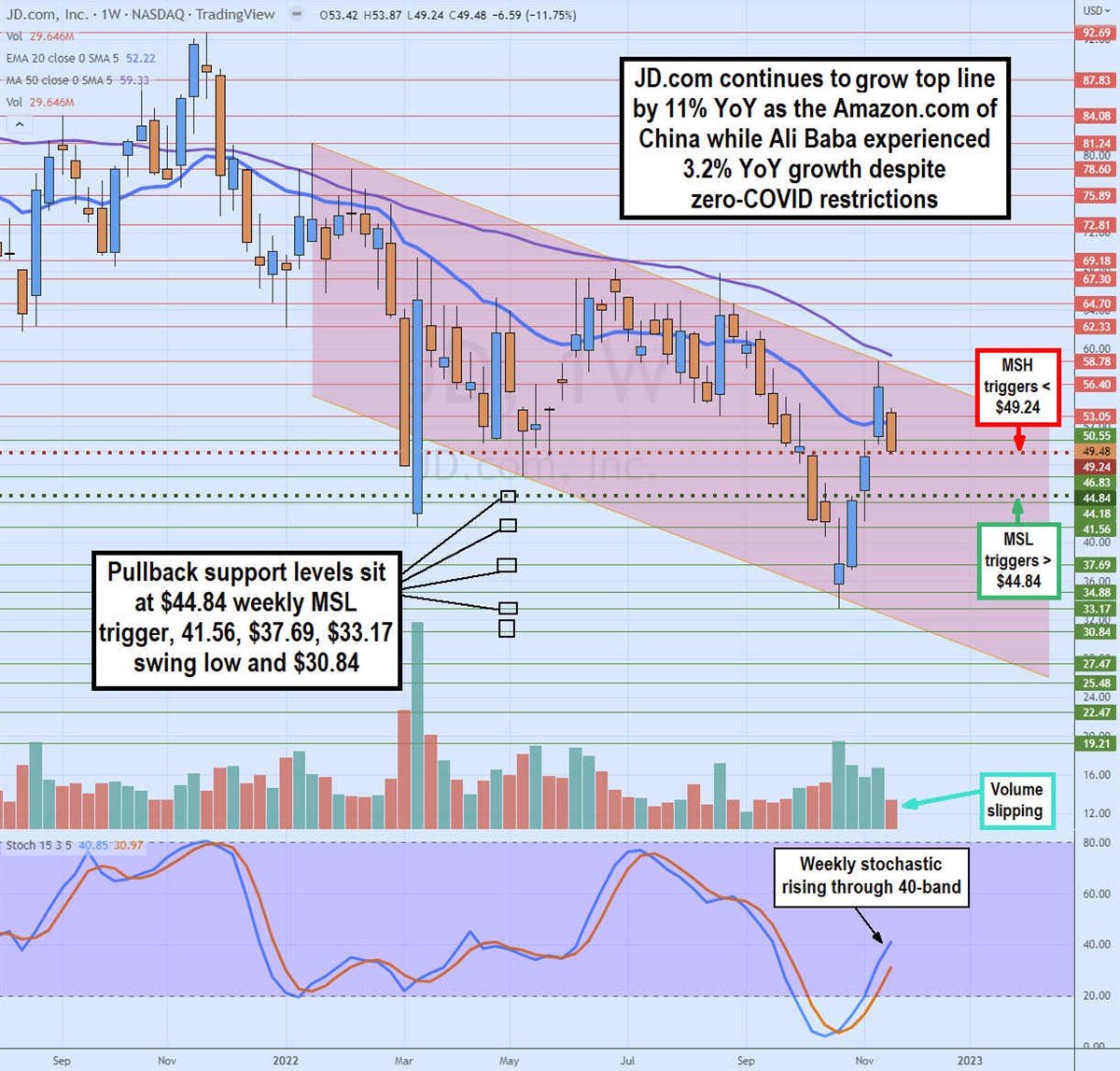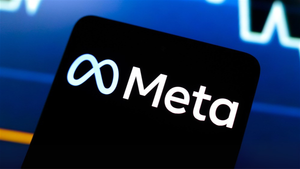Financial News
China’s Zero-COVID Restrictions Can’t Stop JD.com
 China’s largest online retailer JD.com (NASDAQ: JD) is also its largest internet company by revenue. It is often referred to as the Amazon (NASDAQ: AMZN) of China. The Company not only generates e-commerce revenues but also has a logistics division that has managed to increase revenues at a 20% annual clip and is finally hitting profitability. JD is continuing to show positive top-line growth while competitor Ali Baba (NASDAQ: BABA) has seen growth slow to low single digits in the same period. From household items to computers and electronics to cosmetics, apparel, baby and pet supplies to groceries and food delivery, JD carries everything and is a master of optimizing the supply chain. It’s Shop Now 1-hour delivery service recorded triple-digit general merchandise value (GMV) growth covering the majority of supermarket chains in China. The Company has seen its fastest growth in the home appliances, fresh goods, health, sports, and pets categories. Its nationwide fulfillment network cover 99% of China’s population. The Company is in a leading position to snap back sharply when COVID is finally in the rearview mirror in China, but that day seems to be getting pushed farther away with surging cases.
China’s largest online retailer JD.com (NASDAQ: JD) is also its largest internet company by revenue. It is often referred to as the Amazon (NASDAQ: AMZN) of China. The Company not only generates e-commerce revenues but also has a logistics division that has managed to increase revenues at a 20% annual clip and is finally hitting profitability. JD is continuing to show positive top-line growth while competitor Ali Baba (NASDAQ: BABA) has seen growth slow to low single digits in the same period. From household items to computers and electronics to cosmetics, apparel, baby and pet supplies to groceries and food delivery, JD carries everything and is a master of optimizing the supply chain. It’s Shop Now 1-hour delivery service recorded triple-digit general merchandise value (GMV) growth covering the majority of supermarket chains in China. The Company has seen its fastest growth in the home appliances, fresh goods, health, sports, and pets categories. Its nationwide fulfillment network cover 99% of China’s population. The Company is in a leading position to snap back sharply when COVID is finally in the rearview mirror in China, but that day seems to be getting pushed farther away with surging cases.Zero Tolerance Counterfeit Merchandise Policy
To combat the tarnished image of counterfeits and knock-offs in China, JD has a one-strike “zero tolerance” policy to permanently ban and fine any merchants selling counterfeits on its platform. This has enticed many luxury European brands to partner with the Company to offer authentic luxury, and premiere products directly sourced from the designers. JD is the first platform to establish a partnership with nine luxury brands under the LVMH Group (OTCMKTS: LVMUY) after onboarding Italian fashion brand Fendi. JD also had a number of widely regarded brands join its platform including Christian Louboutin, La Prairie, and Lululemon Athletica (NASDAQ: LULU). The Company strives to maintain high quality over knock-offs and counterfeits with its direct control over the supply chain.
Double Digit Growth
JD.com reported its fiscal Q3 2022 earnings on Nov. 18, 2022. The Company reported earnings-per-share (EPS) of RMB 6.27 per share beating consensus analyst estimates for RMB 4.46, by RMB 1.81. Revenues climbed 11.4% year-over-year (YoY) to RMB 243.53 billion or $34.2 billion, missing analyst estimates for RMB 243.77 billion, by (-$270 million). Annual active customer accounts rose 6.5% to 588.3 million. JD.com CEO Lei Xu commented, “We are pleased that JD.com's high-quality growth is increasingly powered by the millions of SMEs, especially in rural industries that look to us for the most efficient supply chain solutions and sustainable growth opportunities. Looking ahead, we are confident that our well-established supply chain infrastructure, technical capabilities, as well as the social responsibility we shoulder, will continue to enable JD.com to play an important role in the new development phase in the years to come.”

Dueling Weekly Market Structure Triggers
JD shares have been in a year-long falling price channel that put in a bottom at $33.17 on Oct. 24, 2022, before staging a sharp rally into its Q3 2022 earnings upon triggering its weekly market structure low (MSL) buy trigger above $44.84. Shares managed to peak at $58.78 after releasing strong earnings only before a sell-the-news wave of selling formed a weekly market structure high (MSH) sell trigger below $49.24. This sets up an interesting bull versus bear dueling market structure triggers with the bulls attempting to hold the line at the $44.84 MSL buy trigger and bears at the $49.24 sell trigger. The weekly 20-period exponential moving average (EMA) is flattening at $52.22 while the weekly 50-period MA continues to fall at $59.33. The weekly stochastic continues to rise through the 40-band but volume took a dramatic slip to just half of the prior week’s volume heading into earnings. Pullback support levels sit at the $44.84 MSL trigger, $41.56, $37.69, $33.17 swing low, and $30.84.
COVID Restrictions Impact on Logistics
The Company addressed the logistics disruptions stemming from the zero-COVID policy. It’s had the heaviest impact in 2022 as 17% of customer home addresses have been affected by COVID control measures making it the worst year in terms of fulfillment. It has resulted in higher rates of cancelations and longer waiting times. However, JD Logistics (JDL) remains number one in the industry due to its supply chain capability managing over 1,500 warehouses and 30 million square meters. JDL Airlines commenced operations in Q3 2022 to strengthen JDL’s integrated supply chain services. The Company views “… the 20 new rules guiding COVID control policies as positive and constructive towards the recovery of domestic supply chain and consumer confidence,” but will take time to see the positive impact on consumption data according to JD CFO Sandy Xu.
Be Aware of Embedded China Stock Risk
Geopolitical tensions between the U.S. and China have a muted effect on JD shares since it conducts most of its business in China. However, the zero-COVID policy has literally grouped all Chinese stocks or ADR/ADS’ together regardless of individual performance or even sector. Any indications of an easing of COVID restrictions tend to spike Chinese stocks higher, while indications of further clamp downs stemming from record COVID infections tend to rug-pull them down. Investors should be aware that every Chinese stock literally has the same structural risk involved with ownership. This means you may see JD stock down (-10%) along with unrelated Chinese stocks like search engine Baidu (NASDAQ: BIDU), electric vehicle maker NIO (NYSE: NIO) , and fintech Pinduoduo (NASDAQ: PDD) all gapping down (-10%) as well for no reason other than rising COVID cases in China.
More News
View More





Quotes delayed at least 20 minutes.
By accessing this page, you agree to the following
Privacy Policy and Terms Of Service.



